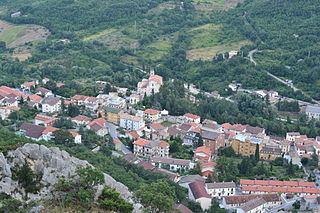
A libretto is the text used in, or intended for, an extended musical work such as an opera, operetta, masque, oratorio, cantata or musical. The term libretto is also sometimes used to refer to the text of major liturgical works, such as the Mass, requiem and sacred cantata, or the story line of a ballet.

General Gabriele D'Annunzio, Prince of Montenevoso, sometimes written d'Annunzio as he used to sign himself, was an Italian poet, playwright, orator, journalist, aristocrat, and Royal Italian Army officer during World War I. He occupied a prominent place in Italian literature from 1889 to 1910 and in its political life from 1914 to 1924. He was often referred to by the epithets il Vate and il Profeta.

Giovanni Zenatello was an Italian opera singer. Born in Verona, he enjoyed an international career as a dramatic tenor of the first rank. Otello became his most famous operatic role but his repertoire also included French roles. In 1904, he created the part of Pinkerton in Madama Butterfly.

Ildebrando Pizzetti was an Italian composer of classical music, musicologist, and music critic.

Alberto Franchetti was an Italian composer and racing driver, best known for the 1902 opera Germania.

Lama dei Peligni is a comune and town in the province of Chieti in the Abruzzo region of Italy with 1,155 inhabitants. It is also part of the Aventino-Medio Sangro mountain community and the municipal territory is included in the Majella National Park. The town, known to naturalists as the country of chamois, is located in a florofaunal area of particular interest.

Taranta Peligna is a comune and town in the province of Chieti in the Abruzzo region of central Italy. It is 57 kilometres (35 mi) from Chieti.

Antonio Pini-Corsi was an Dalmatian Italian operatic baritone of international renown. He possessed a ripe-toned voice of great flexibility and displayed tremendous skill at patter singing. Pini-Corsi participated in numerous operatic premieres, portraying on stage such characters as Ford in Giuseppe Verdi's Falstaff and Schaunard in Giacomo Puccini's La bohème. Part of the first generation of recorded musicians, Pini-Corsi was one of the finest buffo singers of his era.
Literaturoper, a term coined by the German music critic Edgar Istel, describes a genre of opera that emerged during the late 19th century. When an existing play for the legitimate theatre is set to music without major changes and without the intervention of a librettist, a “Literaturoper” is the result. Although the term is German, it can be applied to any kind of opera, irrespective of style or language.

The Grotta del Cavallone, also known as the Grotta della Figlia di Jorio, is a cave located near Lama dei Peligni in Taranta Peligna, in the province of Chieti, Abruzzo, Italy. It is open during the warmer months; an admission fee is charged.

Leopoldo Mugnone was an Italian conductor, especially of opera, whose most famous work was done in the period 1890–1920, both in Europe and South America. He conducted various operatic premieres, and was also a composer of operas.
Tomaso Benvenuti was a nineteenth-century Italian composer of opera. He was born in Cavarzere in the Veneto and died in Rome at the age of 68.

Giovacchino Forzano was an Italian playwright, librettist, stage and film director. A resourceful writer, he authored numerous popular plays and produced opera librettos for most of the major Italian composers of the early twentieth century, including the librettos for Giacomo Puccini's Suor Angelica and Gianni Schicchi.

Gloria is a tragic opera in three acts by Francesco Cilea with an Italian libretto by Arturo Colautti. A variation on the Romeo and Juliet story and set in 14th century Siena, the libretto is based on Victorien Sardou's 1874 play La Haine (Hatred). The opera premiered on 15 April 1907 at La Scala conducted by Arturo Toscanini with Solomiya Krushelnytska in the title role. Gloria was a failure at its premiere when it was withdrawn after two performances and fared little better in the 1932 revised version, although there have been two late 20th century revivals. It proved to be Cilea's last staged opera. In the 43 years following the premiere of Gloria he worked on two or three further operas which were never performed and continued to compose chamber and orchestral music.
Caterina Vertova is an Italian actress. She studied in London and in Paris, as well as at the Actors Studio in New York City.

The Daughter of Iorio is a 1904 play by the Italian writer Gabriele D'Annunzio. The play is written in verse and has elements of local dialect, proverbs and traditional rhymes from Abruzzo. It tells the tragic story of the love between a young female outcast and a shepherd who is being married off to a woman he does not love.

Nicola d'Arienzo was an Italian composer, music pedagogue, and writer on music. He spent his entire career in his native Naples where all but one of his nine of his operas were premiered. His other compositions included instrumental music, sacred music and art songs. From 1909 until 1911, d'Arienzo served as the director of the Conservatory of San Pietro a Majella having taught there since 1875. He also wrote several books on the history and theory of music.
Matteo Fischetti was an Italian pianist and composer active in Naples.

Vittorio Gnecchi (1876–1954) was an Italian composer.


















